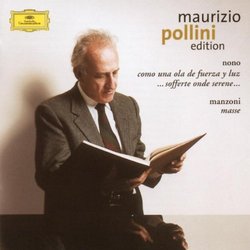| All Artists: Luigi Nono, Giacomo Manzoni, Claudio Abbado, Giuseppe Sinopoli, Bavarian Radio Symphony Orchestra, Sinfonie-Orchester des Bayersichen Rundfunks, Berlin Philharmonic Orchestra, Maurizio Pollini, Slavka Taskova Title: Maurizio Pollini Edition - Nono: Como una ola de fuerza y luz; Manzoni: Masse Members Wishing: 1 Total Copies: 0 Label: Deutsche Grammophon Release Date: 1/14/2003 Genres: Pop, Classical Styles: Vocal Pop, Forms & Genres, Concertos, Symphonies Number of Discs: 1 SwapaCD Credits: 1 UPC: 028947136224 |
Search - Luigi Nono, Giacomo Manzoni, Claudio Abbado :: Maurizio Pollini Edition - Nono: Como una ola de fuerza y luz; Manzoni: Masse
 | Luigi Nono, Giacomo Manzoni, Claudio Abbado Maurizio Pollini Edition - Nono: Como una ola de fuerza y luz; Manzoni: Masse Genres: Pop, Classical |
Larger Image |
CD Details |
CD ReviewsPowerful collaborative synergies here scarecrow | Chicago, Illinois United States | 01/29/2005 (5 out of 5 stars) "Manzoni is an interesting composer,he has written much for the theatre, having a number of operas, as his Danton & Robespierre. So his musical language has this kind of chordal power building great walls of timbre. He is far more direct with classical shapes of durational frames. He never went off and began again renewed the paradigm of timbre as Luigi Nono had done unpretenciously the last ten years of his life. But here this hommage to another innovator Edgar Varese is a fitting proper tribute, incredibly powerful in gesture.
Pollini had worked with Nono also Claudio Abbado in the Seventies when his career as piano soloist had not quite takened off yet. the "serene waves endured" here is a beautiful piece where Pollini had prerecorded materials for playback on the tape (nastro magneticco) that is altered made more thuddy even tympani-like timbres emerge from the speakers. The speakers are place to the right and left of the piano and uder it as well. It was original quadraphonic but Nono thought this perhaps to impersonal and collective too large for a piece of music that gestures toward an introspection, a private world, perhaps from the island in Venice where Nono had lived. If you have ever lived in Venice and have heard the waters gentle flapping against the bricks or the peel of bells, you quite correctly see where the gestural focus of this work recides. The live piano part creates a timeless events, simple chords and high register "tinckly" like timbres. Something that the late Morton Feldman has referred to as a sterotypical clique of the avant-garde. Nono however makes more of it than that,having worked out some 186 tone scale between the prerecorded materials and the piano. So it is like there was 186 timbres to work with. The "Como una ola forza" is more an extroverted piece dedicated to a Chilean revolutionary murdered, here we find typical Nono strident walls of timbre unresolved tension bound,throwing themselves into the world of the atrocities of the globe. The vocalist comes to shout and sing high register soprano declamations. It is beginning to sound dated now also when you hear the vocal music of Luciano Berio, you have this whispering like declamations that was an integral part of the avant-garde in the Fifties and Sixties. Berio believed it as well which is why he got outside of himself with the more "hip" gestures of his "Sinfonia" which also sounds quite dated now. The Nono here keeps a level of abstraction at work, and this work is rather git-wrenching and difficult to listen to, all the more engaging. Works like these seem to contravene the current scene of new music that is obsessed with popular gestures and being loved by their public, even political works are those of ones of jazzy engaging gestures that draw one in in a :groove" Nono had known no such language. He did remain committed to the paradigm of the post-war avant-garde that of Post-Webern and always had great charts and creative agendas for all his works, as these two here. There is a kind of sureface fluidity Nono discovered a directedness, that the politics of his subject matter had I believe had given him. His political music at least in the Seventies came to be surface bound, and he found the electronics medium as an equivalent to documentary like gestures, where greatoer amounts of raw evidence can be utilzed, as his numerous electronic works attest. He came to really abandon the concert hall venue as a dead end, as many others as well." |
